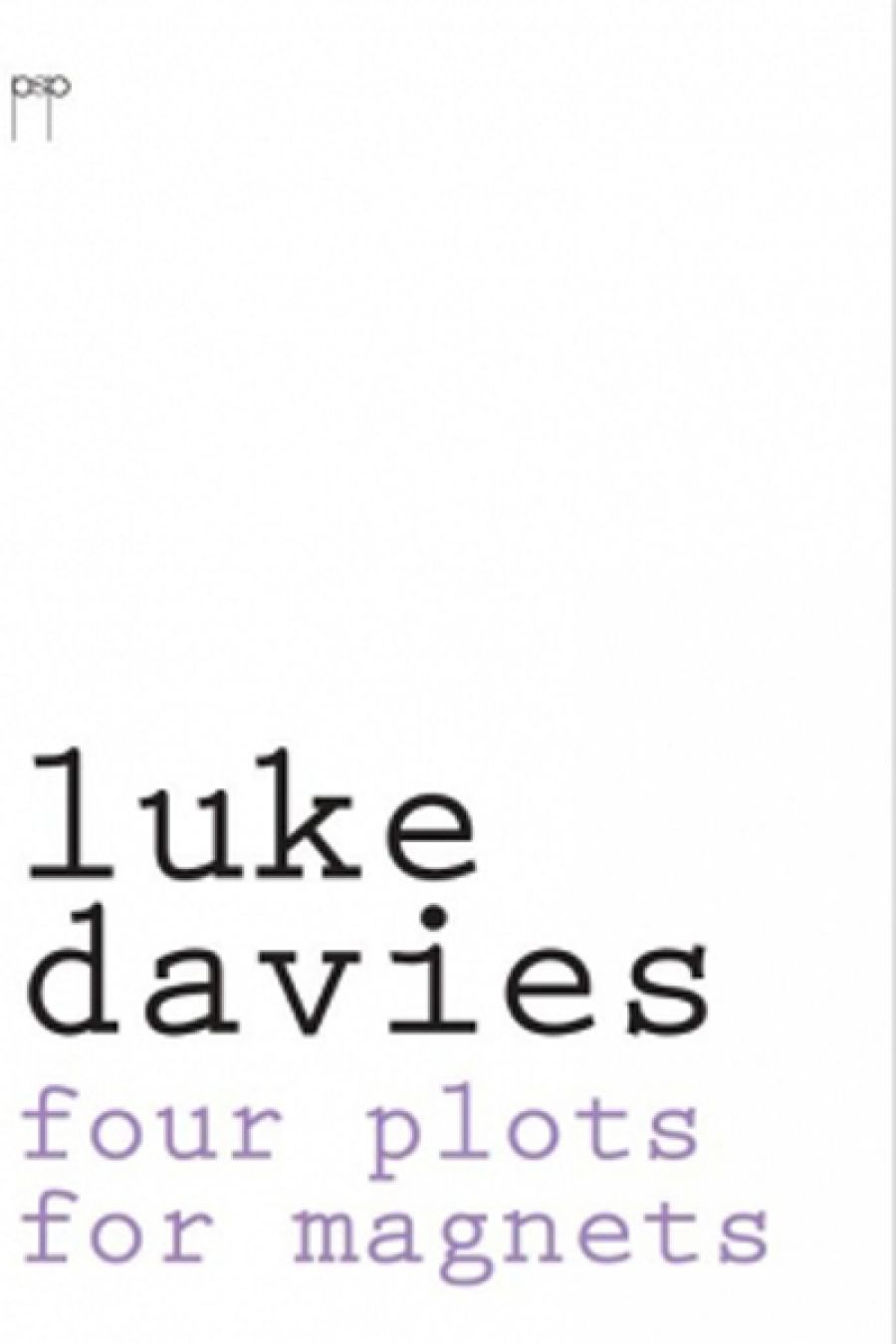
- Free Article: No
- Contents Category: Poetry
- Custom Article Title: Anthony Lynch reviews Luke Davies's 'Four Plots for Magnets'
- Review Article: Yes
- Article Title: Battalions
- Online Only: No
- Custom Highlight Text:
In 1982 a young Steve Kelen published a slim volume by an even younger poet by the name of Luke Davies. Four Plots for Magnets was a chapbook of thirteen poems written mostly when the poet was eighteen and nineteen. Published by Glandular Press, an outlet established by Kelen and the painter Ken Searle in 1980, this ‘sampler’ (as Kelen later calls it) was in a monochrome, staple-bound format. The cover layout came courtesy of another poet, Ken Bolton, its one adornment an image from a 1970 American NFL yearbook illustrating moves in gridiron, a game for which Davies had a childhood obsession.
- Book 1 Title: Four Plots for Magnets
- Book 1 Biblio: Pitt Street Poetry, $20 pb, 132 pp, 9781922080127
Thirty-one years later, Four Plots for Magnets has been reissued by Pitt Street Poetry. Alongside the original thirteen poems come fifty-three poems written by Davies in the same period. The reissue is therefore a considerably thicker volume that retains the simplicity of the original; the cover is blank but for a name, title, and publisher’s logo. The line illustrations of American football moves, like weirdly configured star maps, are reproduced inside.
The new edition also includes a foreword and endnotes by Davies, and an afterword by Kelen. The poets recall their first meeting, when Davies was eighteen, at the University of Sydney. Kelen remembers meeting at the ‘JAY (Joint Association of Youth) Society’, which was ‘like an unofficial franchise of the Hashish Club of Paris’. Davies recollects being ‘obsessed with poetry from age thirteen’, his teenage notebook ‘filled with quotes, from Dransfield to Miroslav Holub, from Frost to Ferlinghetti’. Despite Davies’ urge to drop out and live the life of a beat poet, the University of Sydney subsequently proved ‘a place so fecund with ideas that for the next four years the concept of dropping out would have been absurd’. Davies captures his poetic coming of age with wit and affection: ‘Steve Kelen was the first live poet I met who had books published – one of them with an actual spine, rather than staples ...’ In 1981 he moved into a flat with Kelen, as well as into a circle of (mostly male) poets that included Martin Johnston and John Forbes. He also recalls wider circles of unnamed, factionalised poets: ‘That poetry scene seemed less a jolly, anarchic parliament of like-minded practitioners than a kind of occasional meeting place for the paranoid, the angry and the self-important.’ Thirty years later, as Davies notes, some ‘still see themselves as belonging to battalions’.
Being for a time ‘a kind of minor teenage pot baron’, Davies wrote a number of poems taking starry trips into rhyming couplets: ‘near wisemans ferry when o / pium nearly knocked us over our legs were running far below’ (‘The Spin Trade (Adventures In)’). Davies’ novel Candy (1997) would explore drug addiction with insight born of experience.
In both the original thirteen poems and the fifty-three additional poems, Davies moves between free verse and playful excursions into, and disruptions of, traditional forms. Amid ironic exclamations of ‘O’ and appropriations of Shakespeare, Marvell, and Coleridge come allusions to television shows such The Saint and Thunderbirds and images from genre films, in particular westerns:
... If tomorrow
the world turned upside-down
we would slowly adjust to watching
movies, perhaps. Or look before
diving, for fear of the air. If
I was a cowboy!
The above lines from ‘Love Sonnet’ were redeployed in ‘Safety of Descent’ in Running with Light (1999). When assembling the new edition of Four Plots, Davies discovered that over the years he had, unintentionally, cannibalised a number of previously unpublished poems.
Three poems in the original Four Plots reappeared (intentionally) in Davies’ first full-length collection, Absolute Event Horizon (1994). ‘The Gunpowder Plot’ and ‘Jason and the Argonauts’ were reproduced with few changes, but ‘Not Even the Island Is Brief’ morphed into quite a different poem in ‘Not Even the Island Brings Relief’. In the reissue of Four Plots, all thirteen original poems resume their 1982 personages, with the fifty-three ‘new’ poems published as a kind of historical record, largely as Davies first wrote them.
In his afterword, Kelen notes: ‘Some of the poems had a way of making a spiritual invocation but were pleasingly cognisant of the commercial gods.’ ‘Everything Fab touches turns to clean,’ quotes Davies at the start of ‘Commercial Poem II’ in a line that captures commercial imperatives with evangelical flourish. Some poems also atomise physics. ‘Suicide Amour’ and ‘Adventure Story’ parody colonial travel narratives. Others mesh the Romantic with anti-Romantic – ‘... at night listen / to the sounds of cars being stolen’ (‘The New Year’).
The young Davies tested the boundaries of image, language, and form, and Four Plots for Magnets includes poems where finding magnetic north is no routine matter. But when Kelen chose the thirteen poems comprising that original sampler, Davies, one imagines, already had enough strong material to make selection difficult. It is therefore pleasing to see this extended selection, including possibly the poet’s first ‘adult’ poem, ‘Leaving Adolescence’: ‘so like an oarsman on a fading raft / I turn, and smile, and out-of-tunely sing’. With its intimations of mortality, this is more than a good post-adolescent poem. It’s a good poem, full stop.


Comments powered by CComment